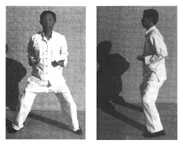“Many may learn, but few will master.”
Bok-Nam Park
Adapted and Re-edited by F. Hriadil
Many people today have learned about Internal Energy and wish to cultivate it for various reasons. Their reasons may range from promoting better health and longer life to creating a higher level of spiritual consciousness. The true martial artist, though, seeks to cultivate Internal Energy and direct it to the limbs for fighting application, as well as healing application. In this article, we will discuss a set of exercises designed to bring this mythical internal power to the palm. These exercises are called, “The Forty-Eight Month Palms.”
The following chart lists each exercise, or palm, by name in no particular order as they do not have to be practiced in any particular sequence:
| CHINESE NAME | ENGLISH TRANSLATION |
| Dan Huan Zhang | Single Palm Strike |
| Shuang Huan Zhang | Double Palm Strike |
| Shui Zhang | Throwing Palm |
| Pu Zhang | Slapping Palm |
| Tuo Zhang | Lifting Palm |
| Kan Zhang | Chopping Palm |
| Bai Yun Zhui Xing Zhang | White Clouds Chasing the Stars Palm |
| Tui Chuang Wang Yue Zhang | Sliding the Shutters to Look at the Moon Palm |
These techniques should not be confused with the Eight Mother Palms of Ba Gua Zhang. The Forty-Eight Month Palms acquired their name from the amount of time traditionally needed to master these eight particular palm striking techniques. Traditionally, the student is taught one palm technique every six months and during that time he/she is expected to practice that technique for at least one hour every day. Practicing in this manner makes the technique reflexive and gives the student an awareness of the proper body alignment, body mechanics, and Qi Gong skill needed to elicit power from that particular technique. Each succeeding six months brings a new palm technique and more practice until all eight are learned and mastered, hence the name “Forty-Eight Month Palms.”
In general, this type of training is not often well received by most present-day students because of the monotonous repetition required and prolonged practice involved in mastering each technique. Consequently, my training methods have been modified to make the practice a little more compatible with today’s busy schedules and hectic lifestyle without sacrificing the desired result. The palm techniques are now introduced at a faster pace, with each technique being repeated a minimum of one hundred times each day. This is not the same as practicing this set of exercises in the old manner but, as mentioned earlier, the results are still quite satisfactory.
Because the training involved in the Forty-Eight Month Palms is quite rigorous, it is usually reserved for people who have studied Ba Gua Zhang for a while and whose bodies have been properly prepared. The body must be soft and the joints and spine must be very pliable in order to properly execute the whipping motion prevalent in the techniques. The energy from the whipping motion is similar to the energy manifested at the end of a dog’s or horse’s tail. The power is generated at the base of the tail using the muscles and the bones, and, through a shaking or whipping action, the energy is made to travel along the tail manifesting itself even in the very tips of hairs at the end of the tail. This type of whipping energy is very important in the development of power in the palms and is prevalent in all eight of the palm techniques listed above. Attempting this type of training, without first spending sufficient time to properly condition the body, will result not only in the failure to achieve mastery of these palm techniques, but may also harm the body in the process.
By practicing just the Forty-Eight Month Palms, you will eventually “free” the Internal Energy and learn to manifest the Qi (Chi) in the palms. However, if you also prepare yourself by practicing the Ba Gua Zhang basic Du Zhang (Shaking Palm) exercise, and concurrently practice Ba Gua Zhang Qi Gong training, the Internal Energy or Qi will manifest itself more quickly and to a greater degree.
It is beyond the scope of this introductory article to discuss the specific nature and method of each of the Forty-Eight Month Palms or to address in any detail the specific Ba Gua Qi Gong training that is required. [Editor’s Note: Those interested in pursuing a more in depth discussion of the Forty-Eight Month Palms should refer to Sifu Park’s book and companion video entitled: “The Fundamentals of Pa Kua Chang – Volume II: The Method of Lu Shui-T’ien as Taught by Park Bok-Nam,” by Park Bok-Nam and Dan Miller which is available from all prominent martial arts bookstores and mail order catalogs. Also, it is advised that no student should attempt to practice any of these methods without proper training from a certified instructor in Sifu Park’s system.]
In the remainder of this article, I shall confine myself to presenting an explanation of the basic Ba Gua Du Zhang (Shaking Palm) exercise, which you should practice for at least three months on a daily basis before even considering the Forty-Eight Month Palms training.
The basic Shaking Palm exercise is designed to relax and strengthen the waist and shoulders, giving the student a better foundation from which to proceed. It is important to remember that during all palm exercises, you must remain relaxed. If you hold tension in your muscles, you will hinder the flow of blood, lymph fluid, and Qi and this will significantly hinder your progress and development.
The stance that is utilized in the basic Shaking Palm exercise is the Horse Stance (Ma Bu). Here, your feet should be parallel, facing forward, and a little more than shoulder-width apart. Your knees should be kept in line over your feet and, in the beginning, should be bent only to a degree that is comfortable. Remember, you must stay relaxed. Forcing the stance to be too deep too soon will cause you to be distracted by the discomfort and not focused on the main intent of the exercise. To make progress, your mind must be focused on the striking method and not on any pain or discomfort resulting from the stance. In the beginning, you should use a comfortable stance that is at a depth that can be maintained for at least one minute without straining. As you progress, you will be able to practice comfortably in a deeper and deeper stance, which will produce even greater benefit from the exercise.
The hands should be pulled back along the side of your body and held approximately at the height of your lower (floating) ribs. Your elbows should be behind your hands with your palms facing in the Heaven, or Yang, orientation (i.e. palms upward). It is very important that your elbows be kept behind your palms for proper body alignment and mechanics. To prove this for yourself, try this little experiment. With your elbows in the position shown in Figure 1 below (i.e. the elbows turned out), have someone resist your movement as you try to extend your hands forward. Continue to keep your elbows turned out as you push forward. You will find that it is rather difficult to push forward. On the other hand, now place your elbows directly behind your palms as shown in Figure 2 below. This time keep them along the sides of your body as you extend forward. Again, have someone resist your forward movement. What do you feel this time? The task is a lot easier when you have proper body alignment and mechanics. So remember, always keep your elbows behind your palms when striking.

[Elbows Out] [Elbows Back]
Once you have settled into the basic starting posture there are a couple of additional things that must be kept in mind. First, the distance between the bottom of your ears and the top of your shoulders must always be maximized. In other words, you must always sink the shoulders. By drawing or allowing the shoulders to rise upward, tension will be created in the neck and shoulder area which block or reduce the flow of Qi. Internal Energy should never be restricted or wasted in this manner. Second, you need to “place your lungs into your back.” You can do this by slightly rounding the shoulders and thoracic region of your spine. Your lungs should remain “in your back” so that your chest can become “empty” and your diaphragm can operate freely and without restriction.
To begin the basic Shaking Palm exercise, settle into a Horse Stance with the hands, palms up, at your sides as described above. Refer to the step-by-step sequence illustrated in Figure 3 below. Begin the movement by extending the right hand (fingers pointing forward) from its position at the lower ribs to a position at the front, level with the height of the shoulder with the arm fully extended. During this movement, several important things must occur. First, your arm is connected to your body and, as such, does not ever move independently of it. The shoulders and waist must move at the same time your hand is extended forward by the elbow. Second, the palm remains in a Yang, or Heaven, orientation (i.e. palm up) until just before the arm reaches full extension. Then, your palm is turned rapidly to the Yin, or Earth, orientation (i.e. palm forward) to strike. Also, note that your right shoulder should move forward approximately 45 degrees as you strike with your right palm. If you deviate significantly from this orientation, you may experience a loss of balance or power – or both.

[Illustration of the basic Shaking Palm (Du Zhang) Sequence]
For the exercise to remain balanced and to complete the sequence, continue by performing a palm strike on the left side, pulling the right hand back to the ribs and returning its palm to the Yang (or Heaven) orientation as you strike forward with the left palm. All of the principles utilized on the right side apply equally to the left. In addition, as you strike with the left palm, it is better for beginners to think more of the pulling motion on the right side than on the act of striking with the left palm. Focusing on the hitting or striking action too soon in your training, can cause the mind to switch into “fight-or-flight” mode. This can lead you to tense up which will retard or block the flow of Qi. Continue the exercise, alternately striking forward with the right palm then the left palm for a set number of times.
When you practice this basic exercise, you must coordinate the breathing with the movement. All breathing must be done through the nose, both the inhale and the exhale. Before you begin each strike, you must inhale deeply to the Dan Tian. At full extension of your arm, contract the muscles over your Dan Tian and forcefully exhale with a short burst of air through the nose. Also, as you exhale, issue the sound “hummph” in your throat. Keep the sound short and make sure your timing coincides with the strike at its full extension. Making this sound assists you in focusing your energy.
To gain maximum benefit and to develop your body in preparation for performing the “Forty-Eight Month Palms” training, you should practice the basic Shaking Palm exercise a minimum of one hundred times each day. You can accomplish this by performing the exercise in sets: two sets of thirty single-palm strikes (counting each separate palm strike as one) and a final set of forty palm strikes. The first twenty strikes of this final set should be performed as a right-left combination with each strike of the left palm counting as one. The second twenty strikes of this final set are again performed as single-palm strikes (counting each separate palm strike as one).
It should be clear from this brief discussion that mastery of the “Forty-Eight Month Palms” requires hours of arduous training and repetition. It is indeed unfortunate that few people in today’s society have the time and self-discipline to devote themselves to the mastery of such a task. So, it is because of this situation that I say, “Many may learn, but few will master.”
Above is a re- edited reprint of an article that originally appeared in the “INTERNAL ARTS JOURNAL/MAGAZINE,” Volume 7, No.3, Summer 1992, which was published by Paper Lantern Publishing Company. Though no longer being published, back issues are still available by contacting IAM Company; P.O. Box 1777; Arlington, TX 76004.]

